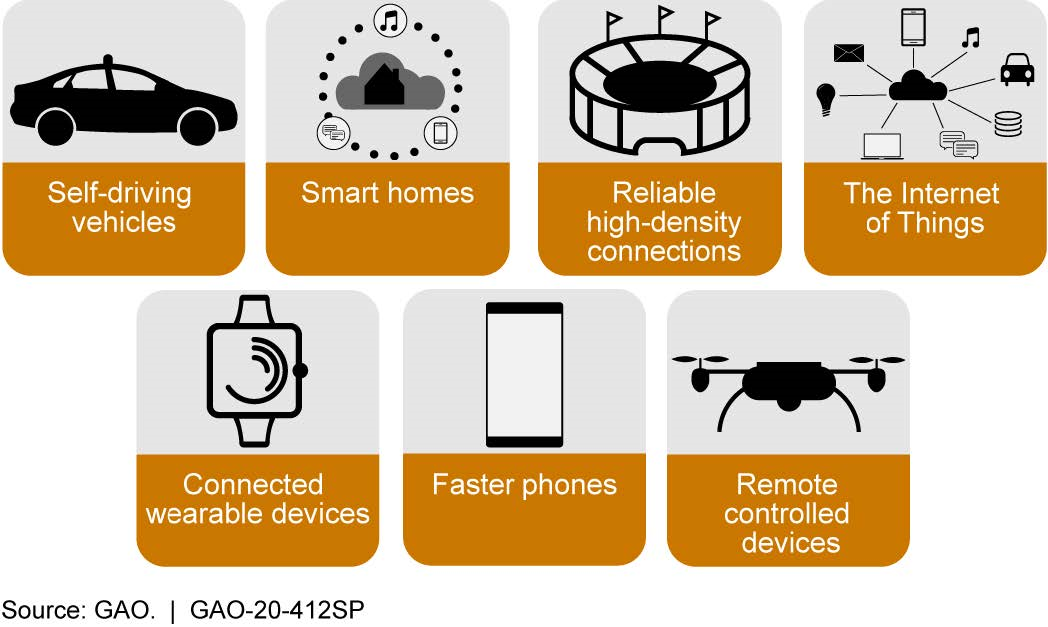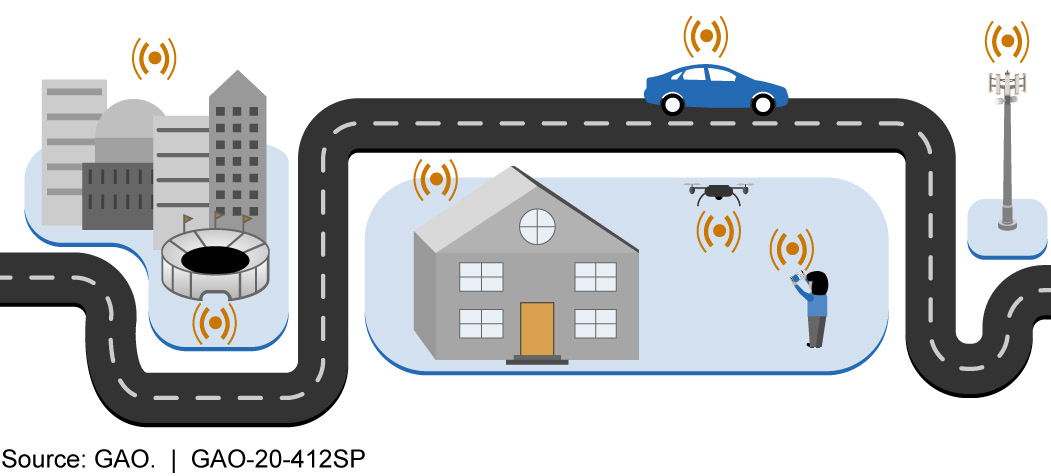Science & Tech Spotlight: 5G Wireless [Reissued with revisions on Mar. 27, 2020.]
Fast Facts
A 5G wireless network will move data faster: potentially 20 times faster than 4G. But it isn’t just for phones—it’s expected to facilitate tech that will transform industries and maybe people’s lives.
By using more of the radio frequency spectrum, along with many other upgrades, 5G will support massive numbers of devices and provide near-instant network responses—enabling technologies like smart cities and self-driving cars, respectively.
This spotlight gives an overview of 5G tech and looks at challenges for federal involvement, including:
making radio frequency spectrum available
improving cybersecurity
addressing disparities in access

Car interior with driver in front, passenger in rear
Reissued with Revisions Mar 27, 2020Revised March 25, 2020 to correct the product number in the page footer and images to read ‘GAO-20-412SP’.
Highlights
Why This Matters
5G wireless is expected to enhance data speeds and could enable transformative applications across transportation, manufacturing, medicine, and other sectors. While 5G could create significant economic opportunities, 5G also raises concerns about cybersecurity risks and associated national security implications, as well as several other challenges.
The Technology
What is it? 5G is a suite of fifth-generation wireless technologies that has the potential to greatly improve mobile communication in several ways. It may lead to faster and more responsive signals from cell phones and other devices. Moreover, it could deliver more reliable connections, higher energy efficiency, the ability to accommodate more devices, and faster network response times (also known as low latency).
These improvements could enable transformative applications such as self-driving vehicles, "smart" manufacturing and agriculture, and remote medical treatment. As with 4G, the most important innovations may not be conceived of until the network is fully implemented.

How does it work? 5G is expected to achieve these improvements in part by using more of the radio spectrum. The current 4G network uses radio frequencies less than 2.6 gigahertz (GHz), which are lower on the spectrum. 5G will begin using higher frequencies, including mid-band (up to 6GHz) and high-band, also known as millimeter wave (over 24GHz). Higher frequencies can support higher data rates, potentially enabling 5G to be over 20 times faster than 4G.
However, as a signal's frequency gets higher, its range and ability to penetrate walls and other barriers decreases. To help overcome this obstacle, one approach is to use smaller, more numerous cell antennas, along with advanced technologies. For example, researchers are developing approaches that would enable each installation to use more antennas and to aim signals to and from antennas, potentially resulting in less interference and more energy efficiency.
Each spectrum band will be best suited to different applications. For example, mid-band's combination of range and data capacity makes it suitable for what is called ultra-reliable and low-latency communication, which is required for applications like self-driving vehicles. High-band, because of its data capacity, will be best suited for dense urban environments or public gathering places like stadiums.
How mature is it? In the United States, telecommunications companies have begun deploying some 5G capabilities within existing 4G networks. The resulting hybrid network can support a class of applications enabled by enhanced mobile broadband, which basically means improved speeds.
Further improvements are expected to become available throughout the 2020s, as companies upgrade from hybrid networks to "stand-alone" 5G networks. Some of the technologies and specifications for other purposes—including ultra-reliable, low latency communications—remain in development. Additionally, telecommunications companies will need to upgrade their 4G network infrastructure to transition from hybrid networks to stand-alone 5G networks to facilitate a greatly expanded number of devices connected to the internet and mission-critical communications for applications like self-driving vehicles.
Opportunities
- Enhanced broadband applications. Faster connections and higher throughput could enhance applications like cloud services, video streaming, gaming, and virtual and augmented reality.
- Internet of Things.5G could connect massive numbers of devices, such as sensors in systems for intelligent transportation and logistics, smart factories, and smart cities. For example, traffic light and road sensors could help reduce car accidents.
- Mission-critical communications. Ultra-reliable, low latency communications could enable more reliable operation of self-driving vehicles, industrial equipment, robots, and drones.
- Economic benefits. 5G deployment could bring new jobs and potentially billions of dollars in economic benefits to the United States.

Challenges
- Spectrum management. To facilitate the growth of 5G, federal agencies may need to ensure the availability of spectrum, particularly in the congested mid-bands, while balancing the needs of existing users. Researchers are also developing new technologies to optimize the use of spectrum.
- Infrastructure deployment. Applications needing low latency and high bandwidth will need significant infrastructure, including fiber optic cables and small cells, which are installations about the size of a pizza box. This installation could be expensive, require skilled labor, and take time for local permitting, planning, and procurement.
- Cybersecurity. Although 5G is expected to deliver security enhancements, the large number of 5G network components increases the risk that some components will not be properly configured to take advantage of the security enhancements. The build-out of 5G has also raised national security concerns, in particular over the supply chain in which foreign companies are major players.
- Digital divide. 5G deployment is expected to start in dense urban areas. As a result, rural and lower-income areas could have less access to 5G and its benefits, widening the digital divide.
- Privacy. 5G networks could allow for much more precise location data because 5G devices are expected to connect to cells that are located much closer, such as feet away versus in previous generations where cells could be miles away. This precise location data could increase the risk to user privacy.
Policy Context and Questions
Although 5G is mainly being deployed by industry, governments and other organizations will decide how to use public resources, such as spectrum, and what obligations network operators will have to their users. Among the questions they will face are the following:
- How can federal agencies manage spectrum to balance the needs of existing users with the needs of 5G users?
- What are the trade-offs between the speed of 5G deployment and ensuring sufficient time for local review of the location of numerous small cell antennas?
- What are the cybersecurity risks of 5G networks and applications, and what can policymakers do to address these?
- How can policymakers ensure equitable access and benefits from 5G?
- What role can policymakers take to ensure that user privacy is protected as 5G networks are deployed?
For more information, contact Karen Howard at 202-512-6888 or howardk@gao.gov.
